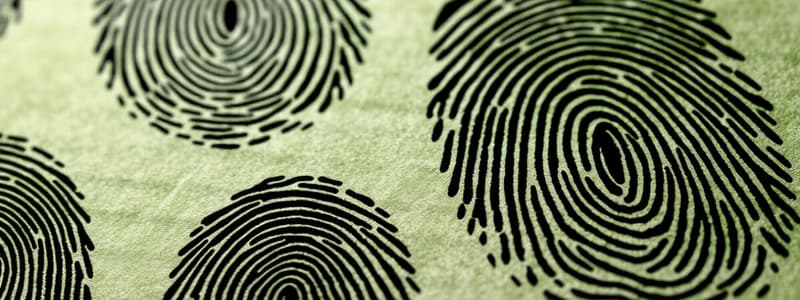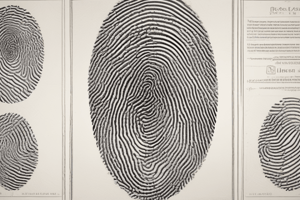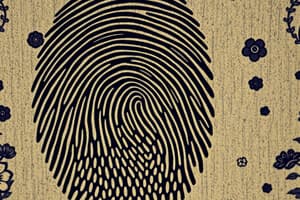Podcast
Questions and Answers
In what year did Sir Francis Galton publish his book "Fingerprints"?
In what year did Sir Francis Galton publish his book "Fingerprints"?
- 1788
- 1888
- 1934
- 1892 (correct)
What is the primary function of the ridges on our fingers?
What is the primary function of the ridges on our fingers?
- To increase sensitivity and improve grip. (correct)
- To provide a unique identifier for each individual.
- To help with blood circulation.
- To prevent excessive sweating.
What is the name of the triangular region found in fingerprint patterns?
What is the name of the triangular region found in fingerprint patterns?
- Whorl
- Core
- Delta (correct)
- Loop
Which of these fingerprint patterns has no deltas?
Which of these fingerprint patterns has no deltas?
What is the classification of a fingerprint pattern that has one delta and ridges entering and leaving on the same side?
What is the classification of a fingerprint pattern that has one delta and ridges entering and leaving on the same side?
Which of the following is NOT one of the three basic fingerprint patterns?
Which of the following is NOT one of the three basic fingerprint patterns?
What was the motivation behind John Dillinger's attempt to remove his fingerprints?
What was the motivation behind John Dillinger's attempt to remove his fingerprints?
Which of the following is NOT a type of whorl fingerprint pattern?
Which of the following is NOT a type of whorl fingerprint pattern?
What is the name of the center of a whorl or loop?
What is the name of the center of a whorl or loop?
What is the term for the study of the uniqueness of friction ridge structures and their use for personal identification?
What is the term for the study of the uniqueness of friction ridge structures and their use for personal identification?
What are points where the ridge structure changes called?
What are points where the ridge structure changes called?
What is the term for the point at which one friction ridge divides into two friction ridges?
What is the term for the point at which one friction ridge divides into two friction ridges?
What is the term for a connecting friction ridge between parallel running ridges?
What is the term for a connecting friction ridge between parallel running ridges?
What is the term for a single friction ridge that bifurcates and rejoins after a short while and continues as a single friction ridge?
What is the term for a single friction ridge that bifurcates and rejoins after a short while and continues as a single friction ridge?
What kind of fingerprint pattern opens towards the thumb?
What kind of fingerprint pattern opens towards the thumb?
In the Henry Classification System, which fingerprint receives a value of 8 points in the primary classification?
In the Henry Classification System, which fingerprint receives a value of 8 points in the primary classification?
The fingerprint classification system used by the FBI is based on what original system?
The fingerprint classification system used by the FBI is based on what original system?
What is the name of the national fingerprint database maintained by the FBI?
What is the name of the national fingerprint database maintained by the FBI?
What is the approximate average response time in minutes for a criminal fingerprint search through IAFIS?
What is the approximate average response time in minutes for a criminal fingerprint search through IAFIS?
What is the name of the device used to upload fingerprints to an AFIS?
What is the name of the device used to upload fingerprints to an AFIS?
What is the name of the killer who was convicted on fingerprint evidence after being identified through a stolen car?
What is the name of the killer who was convicted on fingerprint evidence after being identified through a stolen car?
What is the name of the serial killer who was convicted of murdering two prostitutes whose bodies were found in dumpsters?
What is the name of the serial killer who was convicted of murdering two prostitutes whose bodies were found in dumpsters?
What is the average salary for a fingerprint examiner in the United States?
What is the average salary for a fingerprint examiner in the United States?
Which of the following types of whorls is symmetrical and has two deltas?
Which of the following types of whorls is symmetrical and has two deltas?
What is the term for the point where two ridges intersect?
What is the term for the point where two ridges intersect?
Which of these is a type of human remain classification?
Which of these is a type of human remain classification?
What is the name of the process of removing a body from its burial site?
What is the name of the process of removing a body from its burial site?
What is a Cadaver Dog?
What is a Cadaver Dog?
What is the primary method for locating human remains in a grave?
What is the primary method for locating human remains in a grave?
What is the purpose of establishing a site datum before exhuming a grave?
What is the purpose of establishing a site datum before exhuming a grave?
What is the recommended size for each square in a grid established for sifting soil at a grave site?
What is the recommended size for each square in a grid established for sifting soil at a grave site?
What is the purpose of using different mesh sizes when sifting soil at a grave site?
What is the purpose of using different mesh sizes when sifting soil at a grave site?
What is the recommended tool for carefully removing soil around a body part during excavation?
What is the recommended tool for carefully removing soil around a body part during excavation?
What is the purpose of placing a recovered body part on a Tyvek suit during excavation?
What is the purpose of placing a recovered body part on a Tyvek suit during excavation?
What is the name of the war that took place in Bosnia and Herzegovina between 1992-1995?
What is the name of the war that took place in Bosnia and Herzegovina between 1992-1995?
What is the best method for locating bodies in water?
What is the best method for locating bodies in water?
What type of sonar is best suited for locating remains on the bottom of a smooth surface in large bodies of water?
What type of sonar is best suited for locating remains on the bottom of a smooth surface in large bodies of water?
What is the reason for placing a body located in water into a body bag at the depth of its discovery?
What is the reason for placing a body located in water into a body bag at the depth of its discovery?
What type of evidence was found near San Francisco Bay that led to the arrest of Scott Peterson for the murder of his wife, Laci, and their unborn child?
What type of evidence was found near San Francisco Bay that led to the arrest of Scott Peterson for the murder of his wife, Laci, and their unborn child?
Which of the following is NOT a recommended consideration for exhuming a grave?
Which of the following is NOT a recommended consideration for exhuming a grave?
Flashcards
History of Fingerprints
History of Fingerprints
Tracing the use and study of fingerprints from 200 BC to 1892.
Francisca Rojas Case
Francisca Rojas Case
A 1892 case where a fingerprint led to the murder conviction of Francisca Rojas.
3 Rules of Fingerprints
3 Rules of Fingerprints
Unique to individuals, classified by patterns, and remain unchanged throughout life.
Cores and Delta
Cores and Delta
Signup and view all the flashcards
Fingerprint Patterns
Fingerprint Patterns
Signup and view all the flashcards
Arches
Arches
Signup and view all the flashcards
Loops
Loops
Signup and view all the flashcards
Plain Arch
Plain Arch
Signup and view all the flashcards
Tented Arch
Tented Arch
Signup and view all the flashcards
John Dillinger
John Dillinger
Signup and view all the flashcards
Radial Loop
Radial Loop
Signup and view all the flashcards
Ulnar Loop
Ulnar Loop
Signup and view all the flashcards
Whorl
Whorl
Signup and view all the flashcards
Plain Whorl
Plain Whorl
Signup and view all the flashcards
Central Pocket Loop Whorl
Central Pocket Loop Whorl
Signup and view all the flashcards
Double Loop Whorl
Double Loop Whorl
Signup and view all the flashcards
Accidental Whorl
Accidental Whorl
Signup and view all the flashcards
Ridgeology
Ridgeology
Signup and view all the flashcards
Minutiae
Minutiae
Signup and view all the flashcards
Bifurcation
Bifurcation
Signup and view all the flashcards
Ending Ridge
Ending Ridge
Signup and view all the flashcards
IAFIS
IAFIS
Signup and view all the flashcards
Latent Print Examiner
Latent Print Examiner
Signup and view all the flashcards
Fingerprint Classification System
Fingerprint Classification System
Signup and view all the flashcards
Points of Similarity
Points of Similarity
Signup and view all the flashcards
Types of Human Remains
Types of Human Remains
Signup and view all the flashcards
Expedient Grave
Expedient Grave
Signup and view all the flashcards
Shallow Grave
Shallow Grave
Signup and view all the flashcards
Buried Remains
Buried Remains
Signup and view all the flashcards
Exhumation
Exhumation
Signup and view all the flashcards
Surface Remains
Surface Remains
Signup and view all the flashcards
Probing Method
Probing Method
Signup and view all the flashcards
Cadaver Dog
Cadaver Dog
Signup and view all the flashcards
Methane Gas Detection
Methane Gas Detection
Signup and view all the flashcards
Thermal Tomography
Thermal Tomography
Signup and view all the flashcards
Sifting
Sifting
Signup and view all the flashcards
Establishing a Grid
Establishing a Grid
Signup and view all the flashcards
Aquatic Human Remains
Aquatic Human Remains
Signup and view all the flashcards
Locating Aquatic Remains
Locating Aquatic Remains
Signup and view all the flashcards
Processing Aquatic Remains
Processing Aquatic Remains
Signup and view all the flashcards
Study Notes
Fingerprints: Patterns & Minutiae
- Fingerprints are unique to each individual, including identical twins.
- Fingerprint patterns remain constant throughout a person's life.
- Fingerprints can be used to identify people, as seen in historical uses and case studies.
History of Fingerprints
- Fingerprints were used to sign contracts in Babylon around 200 BC.
- Chinese historian Kia Kung-Yen, in 651 AD, recognized the use of fingerprints for identification.
- Chinese merchants used fingerprints to sign contracts on silk merchandise, as witnessed by Abu Zayd Hasan in 851 AD.
- Christopher Mayer, in 1788 AD, observed the uniqueness of fingerprints.
- Sir Francis Galton documented fingerprints in a book titled "Fingerprints" in 1892.
Case Study: Francisca Rojas
- Francisca Rojas and her siblings were found murdered in 1892.
- Francisca, their mother, was found alive and accused of the murders.
- A bloody fingerprint on the children's bedroom door led to Francisca's confession and conviction.
- Pedro Velazquez, a neighbor, had an alibi, yet was still under suspicion.
Introduction to Fingerprints
- Natural ridges on fingers, toes, palms, and feet create friction ridges making gripping easier.
- Friction ridges leave impressions (prints) on objects.
- Natural secretions and dirt combine to leave the print.
Case Study: John Dillinger
- John Dillinger, a bank robber during the Great Depression, was Public Enemy #1 in 1934.
- Dillinger attempted to alter his appearance with plastic surgery to evade detection.
- He subsequently attempted to alter his fingerprints by burning them with acid.
- The attempt was unsuccessful, and his fingerprints were still visible.
Fingerprints: Cores & Delta
- Fingerprint analysis breaks down into core and delta components.
- The core is the center of a whorl, loop or similar pattern.
- Deltas are triangular regions where ridges change direction.
- Investigators use delta counting to assess fingerprint patterns.
Fingerprint Patterns
- There are three basic fingerprint patterns: arches, loops, and whorls.
- Arches are characterized by ridges entering from one side and exiting the other; no deltas are present.
- Types of arches: Plain and Tented arches.
- Loops have one delta and ridges entering and exiting from the same side; they are classified as radial (toward the thumb) or ulnar (toward the pinky finger).
- Whorls have at least two deltas and a core; types include plain, central pocket loop, double loop, and accidental whorls.
Case Study: Clarence Hiller
- Clarence Hiller was murdered in 1910.
- Thomas Jennings, a recent parolee, was arrested nearby, wearing a torn, bloody coat with a gun.
- A fingerprint on a crime scene railing matched Jennings.
- He was convicted in the US's first fingerprint identification case.
Minutiae
- Ridgeology: studying friction ridge structures and their individuality.
- Minutiae are points where the ridge structure changes, such as ending ridges, bifurcations, dots, short ridges and crosses.
- Points of similarity (minutiae matches) between two fingerprints increase the evidence's strength.
Minutiae (More Detail)
- Different types of minutiae: bifurcations, bridges, eye/enclosures/lakes, ending ridges, dots, short ridges, and crossover.
Fingerprint Classification System
- FBI's classification system, based on Henry System, uses a sequence of right thumb, right index, right middle, right ring, right little, left thumb, ...
- Points are assigned for whorl patterns for each finger.
- These points are totaled to create a fraction.
Case Study: Richard Ramirez
- Richard Ramirez, a serial killer (the "Night Stalker"), terrorized Los Angeles in 1984-85.
- His crimes included burglary, torture, and murder.
- His own fingerprints left at a crime scene led to his arrest and conviction.
IAFIS
- Integrated Automated Fingerprint Identification System (IAFIS) is a national FBI database.
- IAFIS holds over 100 million fingerprints.
- Fingerprints are submitted voluntarily by local, state, and federal law enforcement agencies.
- The average response time in IAFIS is about 27 minutes for criminal fingerprints.
How IAFIS Works
- IAFIS uses computers to record and encode fingerprints digitally.
- Fingerprint patterns are digitally recorded as pictures, which allows for fast comparisons.
- The system then identifies similarities between fingerprints using minutiae.
- A latent print examiner verifies close matches.
Career Spotlight: Latent Print Examiner
- A latent print examiner is a certified forensic technician trained in fingerprint identification and analysis.
- Examiners often analyze and compare fingerprints from crime scenes using databases.
- All matches must be checked manually.
Case Study: Dumpster Serial Killer
- In San Diego, California, a serial killer targeted prostitutes in the 1980s and 1990s.
- Investigators found fingerprints on a garbage bag linked to the killer, Bryan Maurice Jones.
- Jones's fingerprints led to convictions associated with multiple murders.
Studying That Suits You
Use AI to generate personalized quizzes and flashcards to suit your learning preferences.




